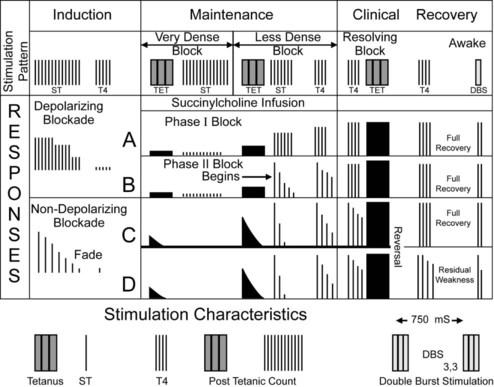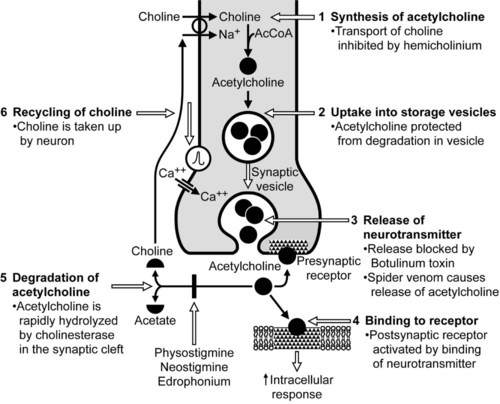I The primary pharmacologic effect of peripheral NMBDs is to produce skeletal muscle (SM) relaxation II NMBDs are potentiated by many other drugs III Other factors that may influence the effects of NMBDs IV Potential mechanisms of SM relaxation A NMBDs interfere with cholinergic (nicotinic) neuromuscular transmission in the peripheral somatic nervous system B Some NMBDs enhance the activity of endogenous inhibitory mechanisms in the central nervous system, which normally modulate SM tone V NMBDs are used adjunctively during anesthesia to produce controlled muscle relaxation VI NMBDs produce muscle relaxation but do not produce analgesia or unconsciousness VII NMBDs produce respiratory paralysis, which necessitates manual or mechanical ventilation support VIII Hypothermia is an important secondary effect of prolonged SM relaxation IX NMBDs are positively charged (ionized) and therefore do not pass the blood-brain barrier or cross the placenta in significant amounts X Various electrical stimulators and stimulation protocols can be used to determine the degree of neuromuscular blockade (Figs. 10-1 and 10-2) I Acetylcholine (ACh) is released in small amounts, even in resting muscles A Random ACh release causes mini-endplate potentials at the postsynaptic muscle membrane, which help to maintain muscle tone but are insufficient to evoke muscle contraction II Action–potential-dependent ACh release A Nerve impulses (action potentials) cause large depolarization in nerve terminals of α-motor neurons B Depolarization in the presence of extracellular Ca++ causes simultaneous fusion of many ACh-containing vesicles with the terminal nerve membrane (Fig. 10-3) C Release of ACh packets (quanta) evokes a large endplate potential, leading to muscle contraction III Combination of ACh with postjunctional nicotinic receptors (Nm receptors) A Receptors on the muscle endplates are nicotinic, type IV cholinergic (Nm) receptors B Strength of muscle contraction is proportional to the number of receptors activated by ACh IV The duration of ACh activity at any cholinergic synapse is limited by the action of acetylcholinesterase (ACh esterase); ACh is metabolized to acetic acid plus choline at the synaptic cleft I Phase I block: depolarizing block (succinylcholine) II Phase II block: nondepolarizing block (atracurium) III Mixed block: any combination of I and II IV Dual block: excessive amounts of depolarizing agents producing phase II block V Nonacetylcholine block (procaine, botulinum, decreased Ca++, increased Mg++, increased K+, decreased K+) I First to last: Oculomotor muscle (m.) → palpebral m., facial m. → tongue and pharynx → jaw and tail → limbs → pelvic m.→ caudal abdominal m. → cranial abdominal m. → intercostal m. → larynx → diaphragm A The sequence of motor blockade is highly variable 1. Intercostal and diaphragmatic muscles are thought to be affected last but the clinical return of functional motor function is highly variable B Motor activity to the limbs may appear to return (twitching, jerking) before the diaphragm is fully functional II Recovery is generally in the reverse order of paralysis III It is possible but difficult to titrate the dose of a specific NMBD to paralyze the muscles of the eye while maintaining diaphragmatic function TABLE 10-1 Dose Of Neuromuscular Blocking Drugs with Side Effects and Contraindications
Neuromuscular Blocking Drugs
Overview
General Considerations
Normal Neuromuscular Function
Types of Neuromuscular Blocks
Muscle Relaxation Sequence
Specific Neuromuscular Blocking Drugs (Tables 10-1 and 10-2)
Agent
Species
Dose Intravenously (mg/kg)
Duration of Action (min)
Side Effects
Contraindications
Succinylcholine chloride
Dog
0.3-0.4
1-38
Little cardiovascular effect; muscarinic effect is bradycardia; nicotinic effects are hypertension, increased intraocular pressure; hyperpyrexia
Organophosphate anthelmintics, chronic liver disease, malnutrition, high-K+, glaucoma, penetrating eye injury
Cat
3-5 (total)
2-6
Pig
0.75-2
1-3
Horse
0.1-0.33
1-10
Pancuronium bromide
Dog
0.02-0.06
15-108
Negligible
Liver or kidney disease
Cat
0.02-0.06
14-15
Pig
0.07-0.12
7-30
Horse
0.08-0.14
16-35
Cattle
0.1
30-40
Calf
0.04
26
Sheep
0.005
21
Vecuronium
Dog
0.01-0.2
10-42
Negligible
Cat
0.02-0.04
5-9
Pig
0.1-0.2
5-20
Horse
0.1
20-40
Sheep
0.004
14
Atracurium
Dog
0.1-0.4
10-30
Cat
0.1-0.25
10-15
Negligible
Pig
0.5-2.5
10-60
Horse
0.07-0.09
8-24
Negligible
Sheep
6 µg/kg/hr
Llama
0.15
6
Cisatracurium
Dog
0.02-0.1
10-30
Negligible
Rocuronium
Dog
0.3-0.6 mg/kg
20-30 min
Negligible
Pipecuronium
Dog
70-90 µg/kg
16-81
Occasional hypotension
Cat
40-60 µg/kg
17-24
![]()
Stay updated, free articles. Join our Telegram channel

Full access? Get Clinical Tree





